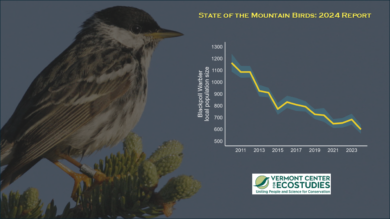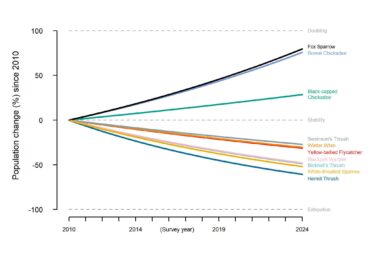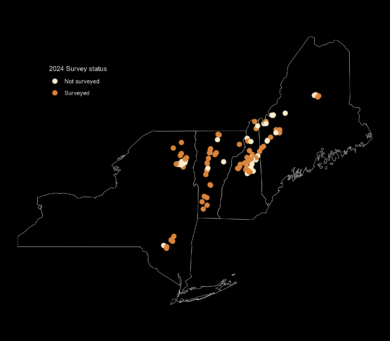
We continue to see declines in species like the Blackpoll Warbler year over year
The State of the Mountain Birds, Northeast 2024 report has landed with a thud on our proverbial desks. Despite a season full of rain (and a little snow), 78 observers and their companions surveyed 71% of the Mountain Birdwatch routes across the montane, spruce-fir zone of the Northeast. These dedicated folks, including a record-breaking 28 first-time observers, arose in the pre-dawn darkness to collect the data contained in this year’s report. The 2024 report is a grim reminder that time is working against us.

The 2024 State of the Mountains report documents continued persistent declines for our monitored spruce-fir specialists in the Northeast, including Yellow-bellied Flycatcher, Bicknell’s Thrush, Blackpoll Warbler, and White-throated Sparrow. Mountain Birdwatch data suggest that these species have declined by an average of 45% since the 2010 season. At this current rate, these declines could collectively exceed 80% by as early as 2048. Let’s hope we can identify conservation actions before then to halt or reverse these trends.
Unfortunately, the mid-elevation species monitored by Mountain Birdwatch have also declined by an average of 39% since 2010. These species, including Winter Wren, Hermit Thrush, and Swainson’s Thrush, are found in good numbers in the spruce-fir zone, but their core populations inhabit the hardwood zone further down the mountains. Many species’ distribution models have predicted that these mid-elevation species may temporarily benefit from climate change by following warming patterns to higher elevations as their preferred climate envelope shifts upslope into newly suitable(-to-them) habitat. That most of the mid-elevation and spruce-fir bird species monitored by Mountain Birdwatch show declining trends, suggests that there may be fewer species than hypothesized that are poised to benefit from climate disruption at higher elevations. The species that are likely increasing in the Mountain Birdwatch dataset are those that are irruptive (Fox Sparrow and Boreal Chickadees) or fare well in montane areas altered by humans (Black-capped Chickadee).

Of the areas monitored by Mountain Birdwatch, the Catskills continue to experience the steepest declines for both mid- and high-elevation species. The Catskills represent the southern extent of the breeding range for some of these species, and we have created two new monitored routes there on Black Dome and Big Indian Mountains since 2023 to improve our monitoring capabilities. Predictions by our colleagues Joel Ralston and Jeremy Kirchman suggest that these species will be entirely lost from the Catskills before the end of this century under modest climate change scenarios.
Next year and beyond will present many challenges for both Mountain Birdwatch and our montane birds. We continue to have difficulties finding folks to monitor Mountain Birdwatch routes in the least-populated areas of Maine. An increasingly wet June makes for fewer monitoring days within the month for Mountain Birdwatchers to complete their routes. Most importantly, the drivers of these population declines are largely unknown for species like White-throated Sparrows and Hermit Thrush. We continue to work with colleagues to discuss research approaches that may shed light on these patterns. Until then, we could use your help. Why not make Mountain Birdwatch your 2025 resolution? To learn more, read the full 2024 report here or sign up to participate in Mountain Birdwatch.
